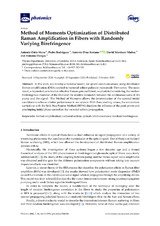Mostrar el registro sencillo del ítem
Method of Moments Optimization of Distributed Raman Amplification in Fibers with Randomly Variying Birefringence
| dc.contributor.author | Ortiz Mora, Antonio | |
| dc.contributor.author | Rodríguez García, Pedro | |
| dc.contributor.author | Díaz Soriano, Antonio Manuel | |
| dc.contributor.author | Martínez-Muñoz, David | |
| dc.contributor.author | Dengra, Antonio | |
| dc.date.accessioned | 2020-10-05T07:26:11Z | |
| dc.date.available | 2020-10-05T07:26:11Z | |
| dc.date.issued | 2020 | |
| dc.identifier.uri | http://hdl.handle.net/10396/20496 | |
| dc.description.abstract | In this work, we develop a vectorial model, for optical communications, using distributed Raman amplification (DRA) applied to vectorial soliton pulses in monomode fiber optics. The main result, a dependent polarization effective Raman gain coefficient, is calculated considering the random birefringence character of the fiber and the relative mismatch between the continuous wave (CW) pump and the signal. The Method of Moments allows the determination of the optimal initial conditions to achieve a better performance in our system. With these starting values, the simulations carried out with the Split-Step Fourier Method (SSFM) elucidate the influence of the peak power and prechirping initial phase control on the vectorial soliton propagation. | es_ES |
| dc.format.mimetype | application/pdf | es_ES |
| dc.language.iso | eng | es_ES |
| dc.publisher | MDPI | es_ES |
| dc.rights | https://creativecommons.org/licenses/by/4.0/ | es_ES |
| dc.source | Photonics 7(4), 86 (2020) | es_ES |
| dc.subject | Raman amplification | es_ES |
| dc.subject | Vectorial soliton | es_ES |
| dc.subject | Optical communications | es_ES |
| dc.subject | Random birefringence | es_ES |
| dc.title | Method of Moments Optimization of Distributed Raman Amplification in Fibers with Randomly Variying Birefringence | es_ES |
| dc.type | info:eu-repo/semantics/article | es_ES |
| dc.relation.publisherversion | https://doi.org/10.3390/photonics7040086 | es_ES |
| dc.rights.accessRights | info:eu-repo/semantics/openAccess | es_ES |

